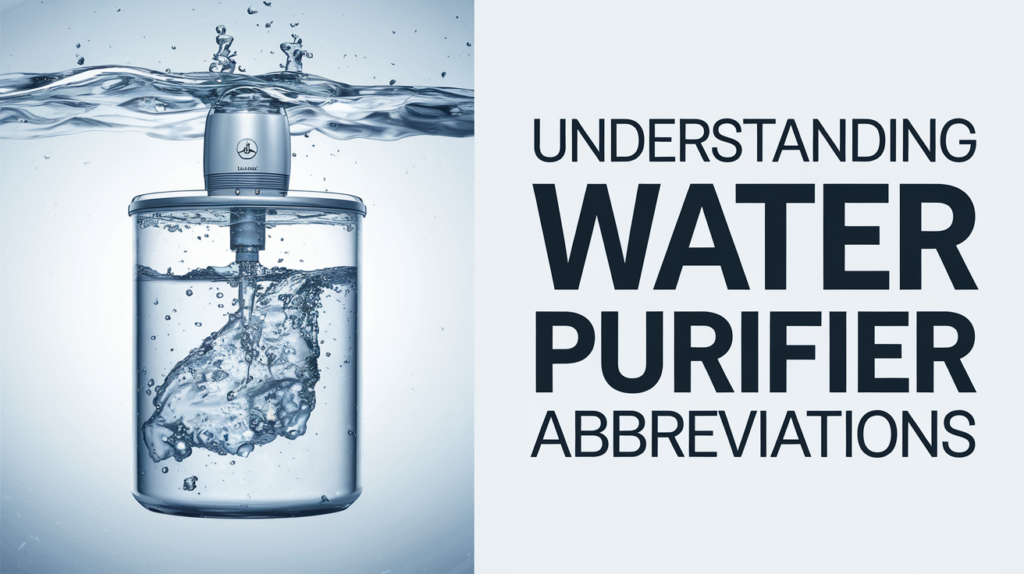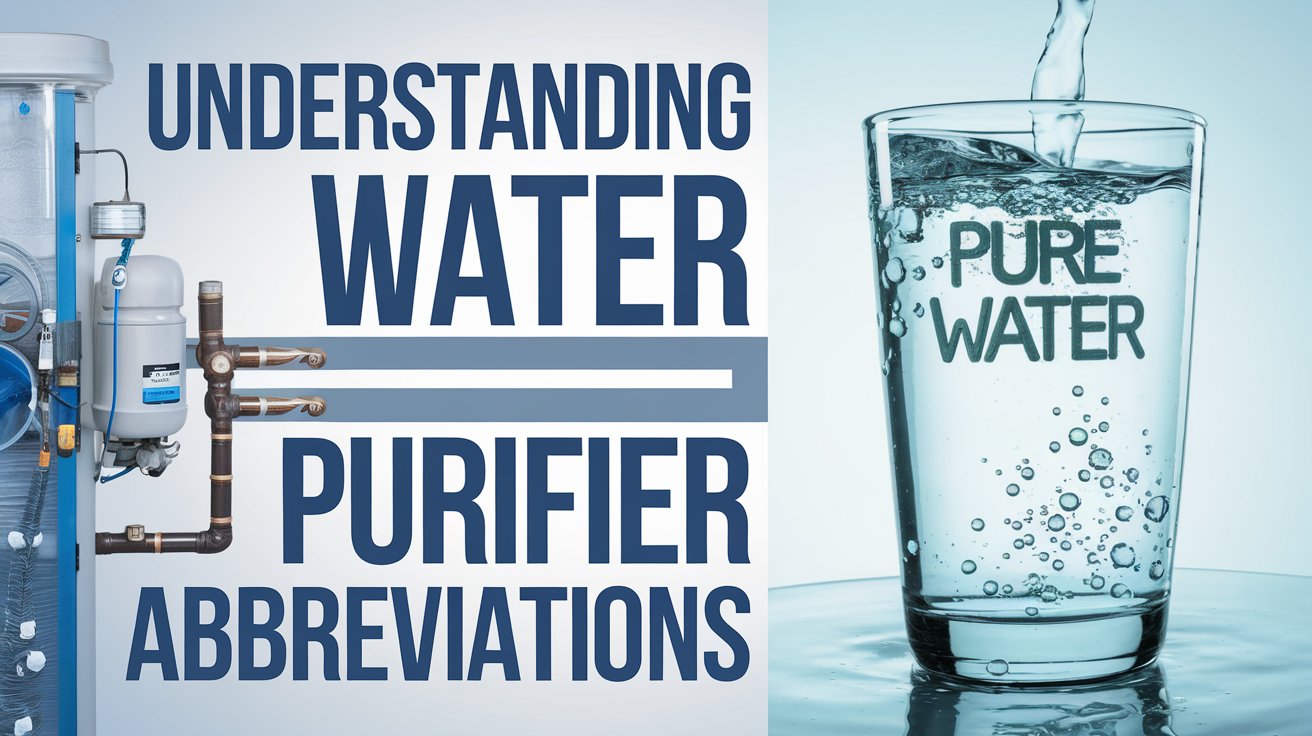Water purifiers play a crucial role in ensuring safe and clean drinking water by utilizing various technologies to eliminate contaminants. With the rise in water purification systems, several abbreviations have become common in the industry.
This article aims to clarify these abbreviations, providing their full forms and explaining their significance in water purification.
Key Abbreviations and Their Full Forms
Here is a comprehensive list of commonly used abbreviations in the water purification industry:
| Abbreviation | Full Form |
|---|---|
| RO | Reverse Osmosis |
| UV | Ultra Violet |
| UF | Ultra Filtration |
| NF | Nano Filtration |
| MF | Micro Filtration |
| MP | Membrane Protector |
| MTDS | Manual Total Dissolved Solids Controller |
| TDS | Total Dissolved Solids |
| BIS | Bureau of Indian Standards |
| ETP | Effluent Treatment Plant |
| STP | Sewage Treatment Plant |
| DM | Demineralization |
| LPH | Litres Per Hour |
| GPH | Gallons Per Hour |
| DWP | Domestic Water Protection |
| MC | Mineral Cartridge |
| AMI | Aqua Mineral Infuser |
| TA | Taste Adjuster |
| AC | Active Copper |
| MZ | Mineral Guard |
| ZPP | Zero Pressure Pump |
| ZLD | Zero Liquid Discharge |
| ME | Mineral Enhancer |
| AS | Antiscalant |
| ROWPU | Reverse Osmosis Water Purification Unit |
| FO | Forward Osmosis |
| MLD | Minimal Liquid Discharge |
Also Read: Best Water Softeners in India

1. RO – Reverse Osmosis
Reverse Osmosis (RO) is a highly effective water purification technology that employs a semi-permeable membrane to separate contaminants from water. It is particularly efficient in removing various types of impurities, including salts, chemicals, and microorganisms. RO systems are widely used in both residential and industrial settings, making them one of the most popular water purification methods.
How RO Works
The RO process involves applying pressure to push water through a semi-permeable membrane, which allows only water molecules to pass while blocking larger contaminants. This method is effective in reducing Total Dissolved Solids (TDS), ensuring that the water is not only safe to drink but also tastes better.
2. UV – Ultra Violet
Ultra Violet (UV) technology utilizes UV light to disinfect water by eliminating microbial contaminants. This method is particularly useful for treating water that is already relatively clean but may contain harmful bacteria, viruses, or other pathogens.
How UV Works
When water passes through a UV chamber, it is exposed to UV light, which disrupts the DNA of microorganisms, rendering them incapable of reproduction. This method is chemical-free and does not alter the taste or quality of the water, making it an eco-friendly option for disinfection.
3. UF – Ultra Filtration
Ultra Filtration (UF) is another water purification method that uses a semi-permeable membrane to separate impurities based on their molecular size. This technology is effective in removing larger particles, such as bacteria and colloids, but allows essential minerals to pass through.
How UF Works
In UF systems, water is forced through a membrane with pores typically ranging from 0.1 to 0.01 microns. This process ensures that larger contaminants are trapped while clean water flows through, making it a suitable option for treating municipal water supplies.
4. NF – Nano Filtration
Nano Filtration (NF) technology is a hybrid process that falls between reverse osmosis and ultra filtration. NF membranes have smaller pores than UF membranes but are larger than RO membranes, allowing them to selectively remove certain contaminants while retaining essential minerals.
How NF Works
The NF process operates at lower pressures than RO, making it more energy-efficient. It effectively removes divalent ions (like calcium and magnesium) while allowing monovalent ions (like sodium and potassium) to pass, thus balancing mineral content in the water.
5. MF – Micro Filtration
Micro Filtration (MF) is a low-pressure membrane filtration process that removes suspended solids, bacteria, and some viruses from water. It is commonly used as a pre-treatment step for reverse osmosis systems.
How MF Works
MF uses membranes with pore sizes ranging from 0.1 to 10 microns. The water is pushed through these membranes, which trap larger particles and microorganisms, resulting in cleaner water.
6. MP – Membrane Protector
The Membrane Protector (MP) is a crucial component in RO systems that helps protect the semi-permeable membrane from scaling and fouling caused by hard water minerals.
7. MTDS – Manual Total Dissolved Solids Controller
The Manual TDS Controller (MTDS) is a feature in some water purifiers that allows users to adjust the TDS levels in their water. This is particularly useful for those who wish to customize the mineral content according to their taste preferences.
8. TDS – Total Dissolved Solids
Total Dissolved Solids (TDS) refers to the total concentration of dissolved substances in water, including minerals, salts, and organic matter. High TDS levels can affect the taste and safety of drinking water.
9. BIS – Bureau of Indian Standards
The Bureau of Indian Standards (BIS) is responsible for establishing quality standards for various products, including drinking water. It ensures that water purification systems meet specific safety and quality guidelines.
10. ETP – Effluent Treatment Plant
An Effluent Treatment Plant (ETP) is designed to treat industrial wastewater and ensure it meets environmental regulations before being released into water bodies. ETPs play a vital role in minimizing pollution and conserving water resources.
11. STP – Sewage Treatment Plant
A Sewage Treatment Plant (STP) is a facility that processes and treats wastewater from households and industries to remove contaminants before the water is released into the environment. The treatment process typically involves physical, chemical, and biological methods.
12. DM – Demineralization
Demineralization (DM) is a water treatment process that removes minerals and salts from water, primarily through ion exchange. This process is essential for applications requiring high purity water, such as in pharmaceuticals and electronics.
13. LPH – Litres Per Hour
Litres Per Hour (LPH) is a measurement used to indicate the flow rate of water purification systems, helping consumers understand how quickly a system can produce purified water.
14. GPH – Gallons Per Hour
Similarly, Gallons Per Hour (GPH) is another flow rate measurement commonly used in water purifiers, particularly in regions using the imperial system.
Also Read: What is Population Equivalent (PE) in Industrial Wastewater Management
Additional Abbreviations
- DWP – Domestic Water Protection: Refers to systems designed to protect household water from contaminants.
- MC – Mineral Cartridge: A component that adds essential minerals back into purified water, enhancing its taste and health benefits.
- AMI – Aqua Mineral Infuser: A system that infuses purified water with essential minerals for improved taste and health.
- TA – Taste Adjuster: A feature that modifies the taste of purified water to suit consumer preferences.
- AC – Active Copper: A technology that infuses copper ions into water, which is known for its antibacterial properties.
- MZ – Mineral Guard: A feature that ensures essential minerals are retained during the purification process.
- ZPP – Zero Pressure Pump: A type of pump that operates efficiently even under low pressure conditions, ensuring consistent water flow.
- ZLD – Zero Liquid Discharge: A process that aims to eliminate wastewater by recovering and reusing water in industrial applications.
- ME – Mineral Enhancer: A system that enriches purified water with minerals to improve its quality and health benefits.
- AS – Antiscalant: A chemical used in water treatment to prevent scaling on membranes and other equipment.
- ROWPU – Reverse Osmosis Water Purification Unit: A compact unit designed for reverse osmosis water purification, often used in remote locations.
- FO – Forward Osmosis: A process that utilizes osmotic pressure to draw water through a semi-permeable membrane, effectively concentrating contaminants.
- MLD – Minimal Liquid Discharge: A water treatment process that minimizes waste by recovering and reusing water.
Conclusion
Understanding the various abbreviations in the water purification industry can help consumers make informed decisions when selecting a water purification system. From reverse osmosis to UV treatment, each technology plays a unique role in ensuring safe and clean drinking water. By being familiar with these terms, you can better appreciate the importance of water purification and its impact on health and well-being.

